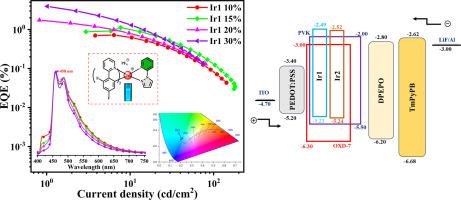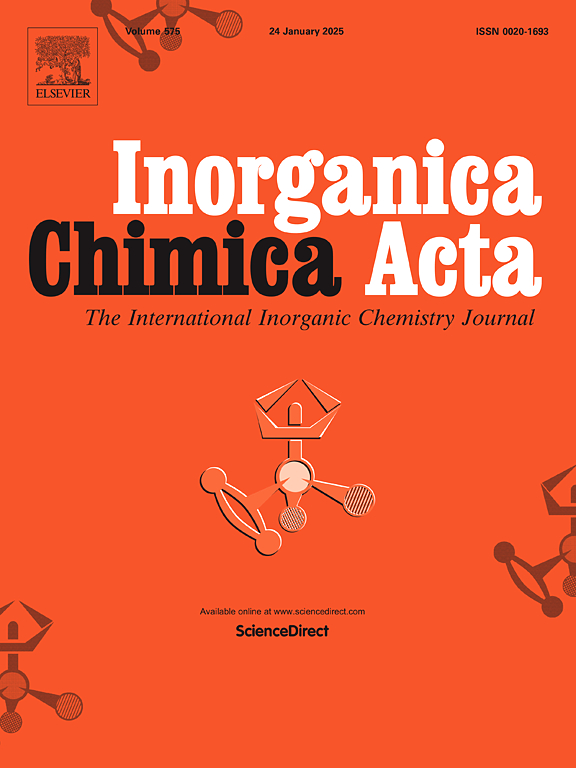Blue-emitting iridophosphors featuring difluorophenylpyridine groups for solution-processed OLEDs
IF 3.2
3区 化学
Q2 CHEMISTRY, INORGANIC & NUCLEAR
引用次数: 0
Abstract
Two blue-emissive cationic iridophosphors (Ir1 and Ir2) featuring 2-(2,4-difluorophenyl)pyridine as the cyclometalated ligand, and 2-(pyrazol-1-yl)pyridine (pzpy) and 4-(dimethylamino)-2-(pyrazol-1-yl)pyridine (dmapzpy) as the auxiliary ligands have been synthesized, and the luminescent characterization of these emitters has been investigated. Solution-phase photoluminescence spectra of Ir1/Ir2 in CH₂Cl₂ exhibited blue emission peaking at 453 and 456 nm, respectively. The electroluminescence based on the two complexes suggested that the electroluminescent performance of the devices significantly improved with increasing the doping concentration. Among them, the device doped with 30 wt% Ir1 demonstrated the optimal performance with the EQEmax of 4.97 %, the maximum luminance of 280 cd/m2, the CEmax of 9.30 cd/A, and the PEmax of 5.31 lm/W.

具有二氟苯吡啶基团的溶液处理oled的蓝色荧光环磷光体
合成了以2-(2,4-二氟苯基)吡啶为环金属化配体,以2-(吡唑-1-基)吡啶(pzpy)和4-(二甲氨基)-2-(吡唑-1-基)吡啶(dmapzpy)为辅助配体的两种蓝色荧光阳离子环吡啶荧光体(Ir1和Ir2),并对它们的发光特性进行了研究。在CH₂Cl₂中,Ir1/Ir2的液相光致发光光谱分别在453 nm和456 nm处呈现蓝色发光峰。基于这两种配合物的电致发光表明,随着掺杂浓度的增加,器件的电致发光性能显著提高。其中,掺量为30 wt% Ir1的器件性能最佳,EQEmax为4.97%,最大亮度为280 cd/m2, CEmax为9.30 cd/A, PEmax为5.31 lm/W。
本文章由计算机程序翻译,如有差异,请以英文原文为准。
求助全文
约1分钟内获得全文
求助全文
来源期刊

Inorganica Chimica Acta
化学-无机化学与核化学
CiteScore
6.00
自引率
3.60%
发文量
440
审稿时长
35 days
期刊介绍:
Inorganica Chimica Acta is an established international forum for all aspects of advanced Inorganic Chemistry. Original papers of high scientific level and interest are published in the form of Articles and Reviews.
Topics covered include:
• chemistry of the main group elements and the d- and f-block metals, including the synthesis, characterization and reactivity of coordination, organometallic, biomimetic, supramolecular coordination compounds, including associated computational studies;
• synthesis, physico-chemical properties, applications of molecule-based nano-scaled clusters and nanomaterials designed using the principles of coordination chemistry, as well as coordination polymers (CPs), metal-organic frameworks (MOFs), metal-organic polyhedra (MPOs);
• reaction mechanisms and physico-chemical investigations computational studies of metalloenzymes and their models;
• applications of inorganic compounds, metallodrugs and molecule-based materials.
Papers composed primarily of structural reports will typically not be considered for publication.
 求助内容:
求助内容: 应助结果提醒方式:
应助结果提醒方式:


